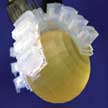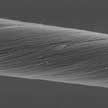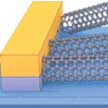Showing Spotlights 9 - 16 of 315 in category All (newest first):
 Breath is one of the main sources of human health parameters that can be used for predicting the state of internal organs. Exhaled breath composition is very complex and the existence of disease marker molecules can be as low as one part per million. That means that using breath for health monitoring purposes requires highly sensitive tools with a recognition ability down to single molecules. Researchers developed a method for fast, on-site and still accurate breath analysis that does not need special preparation of breath samples. The method is based on an electronic nose platform that uses a set of single-walled carbon nanotube sensors deposited on flexible substrates and modified by different semiconducting organic molecules.
Breath is one of the main sources of human health parameters that can be used for predicting the state of internal organs. Exhaled breath composition is very complex and the existence of disease marker molecules can be as low as one part per million. That means that using breath for health monitoring purposes requires highly sensitive tools with a recognition ability down to single molecules. Researchers developed a method for fast, on-site and still accurate breath analysis that does not need special preparation of breath samples. The method is based on an electronic nose platform that uses a set of single-walled carbon nanotube sensors deposited on flexible substrates and modified by different semiconducting organic molecules.
May 13th, 2020
 Researchers exploited for the first time cellular self-recognition process for targeting glioblastoma cells with boron nitride nanotubes (BNNTs), a biocompatible, yet inorganic, nanomaterial.
The team loaded the BNNTs with doxorubicin, a powerful chemotherapy drug, and then functionalized them with glioblastoma cell membranes This targeting approach benefits from the ability of cancer cells to recognize each other due to similarities present on their membrane that make them different from healthy cells.
Researchers exploited for the first time cellular self-recognition process for targeting glioblastoma cells with boron nitride nanotubes (BNNTs), a biocompatible, yet inorganic, nanomaterial.
The team loaded the BNNTs with doxorubicin, a powerful chemotherapy drug, and then functionalized them with glioblastoma cell membranes This targeting approach benefits from the ability of cancer cells to recognize each other due to similarities present on their membrane that make them different from healthy cells.
May 11th, 2020
 Electronic skin (e-skin) technology will give prosthetics and soft robotics a finer sense of touch, of what's hard and soft, hot and cold, smooth and rough. Researchers have now demonstrated a soft robotic hand integrated with four tactile force sensors and one temperature sensor to give it similar sensitivity to a human hand. By integrating an e-skin, the tactile pressure to grab an object and the friction movement of an object from the hand can be monitored. Thanks to the arrangement of multiple tactile sensors, e-skin-integrated soft robotic hand also can monitor sliding of an object by detecting the time delay of the tactile force.
Electronic skin (e-skin) technology will give prosthetics and soft robotics a finer sense of touch, of what's hard and soft, hot and cold, smooth and rough. Researchers have now demonstrated a soft robotic hand integrated with four tactile force sensors and one temperature sensor to give it similar sensitivity to a human hand. By integrating an e-skin, the tactile pressure to grab an object and the friction movement of an object from the hand can be monitored. Thanks to the arrangement of multiple tactile sensors, e-skin-integrated soft robotic hand also can monitor sliding of an object by detecting the time delay of the tactile force.
Jun 20th, 2019
 Carbon nanotube (CNT) fiber is an important one-dimensional macroscopic material. The directional assembly of CNTs can help the fiber realize high mechanical, high electrical and high thermal performance. By introducing thermosetting polymer between the carbon nanotube fibers, the cured polymer can overcome the weak van der Waals interaction between the CNTs and further improve the fiber thermal transport. This results in an effective improvement in thermal conductivity and mechanical properties of CNT fibers.
Carbon nanotube (CNT) fiber is an important one-dimensional macroscopic material. The directional assembly of CNTs can help the fiber realize high mechanical, high electrical and high thermal performance. By introducing thermosetting polymer between the carbon nanotube fibers, the cured polymer can overcome the weak van der Waals interaction between the CNTs and further improve the fiber thermal transport. This results in an effective improvement in thermal conductivity and mechanical properties of CNT fibers.
May 21st, 2019
 Despite the rise of graphene and other two-dimensional (2-D) materials, semiconducting single-walled carbon nanotubes are still regarded as strong candidates for the next generation of high-performance, ultra-scaled and thin-film transistors as well as for opto-electronic devices. In new work, a European team of researchers demonstrates simultaneous confinement of electrons and holes between artificial defects separated by less than 10 nm in semiconducting carbon nanotubes.
Despite the rise of graphene and other two-dimensional (2-D) materials, semiconducting single-walled carbon nanotubes are still regarded as strong candidates for the next generation of high-performance, ultra-scaled and thin-film transistors as well as for opto-electronic devices. In new work, a European team of researchers demonstrates simultaneous confinement of electrons and holes between artificial defects separated by less than 10 nm in semiconducting carbon nanotubes.
Mar 16th, 2018
 The detection of carbon monoxide (CO) in the air is a vital issue, as CO is a highly toxic gas and an environmental pollutant. Carbon monoxide is poisonous because it blocks the binding site for oxygen in hemoglobin. It is exactly this principle - a porphyrin ring with a central iron or cobalt atom that the poisonous gas attaches to - that can be used to implement sensors to warn against carbon monoxide. While carbon monoxide sensors have been extensively researched and commercialized, none make use of a molecule that can be voltage-activated using a newly reported method.
The detection of carbon monoxide (CO) in the air is a vital issue, as CO is a highly toxic gas and an environmental pollutant. Carbon monoxide is poisonous because it blocks the binding site for oxygen in hemoglobin. It is exactly this principle - a porphyrin ring with a central iron or cobalt atom that the poisonous gas attaches to - that can be used to implement sensors to warn against carbon monoxide. While carbon monoxide sensors have been extensively researched and commercialized, none make use of a molecule that can be voltage-activated using a newly reported method.
Dec 20th, 2017
 Researchers have focused on nanocellulose as a novel biomaterial with industrial and scientific applications, which range from the creation of new kinds of commercially useful materials and uses in medical technology all the way to the food and pharmaceutical industries. Engineers now have developed a new use for nanofibrillated cellulose by combining it with carbon nanotubes to form strong, conductive microfibers through a 3D-printing process. The team's 3D-printed wood nanocellulose-carbon nanotube microfibers combine high electrical conductivity and mechanical strength, which can be potentially used in wearable electronics with high performance and low cost.
Researchers have focused on nanocellulose as a novel biomaterial with industrial and scientific applications, which range from the creation of new kinds of commercially useful materials and uses in medical technology all the way to the food and pharmaceutical industries. Engineers now have developed a new use for nanofibrillated cellulose by combining it with carbon nanotubes to form strong, conductive microfibers through a 3D-printing process. The team's 3D-printed wood nanocellulose-carbon nanotube microfibers combine high electrical conductivity and mechanical strength, which can be potentially used in wearable electronics with high performance and low cost.
Sep 25th, 2017
 Turning atmospheric carbon dioxide (CO2) into valuable products seems like a great idea to help remove this greenhouse gas to mitigate climate change. Using a process of molten carbonate electrolytic transformation of CO2 to carbon nanotubes, researchers have now demonstrated 'carbon nanotube wool'. These are the first carbon nanotubes that can be directly woven into a cloth as they are of macroscopic length (over 1mm) and are cheap to produce. The sole reactant to produce the carbon nanotube wools is carbon dioxide. This transforms CO2 from a pollutant into a useful, valuable resource.
Turning atmospheric carbon dioxide (CO2) into valuable products seems like a great idea to help remove this greenhouse gas to mitigate climate change. Using a process of molten carbonate electrolytic transformation of CO2 to carbon nanotubes, researchers have now demonstrated 'carbon nanotube wool'. These are the first carbon nanotubes that can be directly woven into a cloth as they are of macroscopic length (over 1mm) and are cheap to produce. The sole reactant to produce the carbon nanotube wools is carbon dioxide. This transforms CO2 from a pollutant into a useful, valuable resource.
Jul 18th, 2017
 Breath is one of the main sources of human health parameters that can be used for predicting the state of internal organs. Exhaled breath composition is very complex and the existence of disease marker molecules can be as low as one part per million. That means that using breath for health monitoring purposes requires highly sensitive tools with a recognition ability down to single molecules. Researchers developed a method for fast, on-site and still accurate breath analysis that does not need special preparation of breath samples. The method is based on an electronic nose platform that uses a set of single-walled carbon nanotube sensors deposited on flexible substrates and modified by different semiconducting organic molecules.
Breath is one of the main sources of human health parameters that can be used for predicting the state of internal organs. Exhaled breath composition is very complex and the existence of disease marker molecules can be as low as one part per million. That means that using breath for health monitoring purposes requires highly sensitive tools with a recognition ability down to single molecules. Researchers developed a method for fast, on-site and still accurate breath analysis that does not need special preparation of breath samples. The method is based on an electronic nose platform that uses a set of single-walled carbon nanotube sensors deposited on flexible substrates and modified by different semiconducting organic molecules.
 Subscribe to our Nanotechnology Spotlight feed
Subscribe to our Nanotechnology Spotlight feed





